light SAAB 9-2X 2005 Owners Manual
[x] Cancel search | Manufacturer: SAAB, Model Year: 2005, Model line: 9-2X, Model: SAAB 9-2X 2005Pages: 444, PDF Size: 5.76 MB
Page 331 of 444
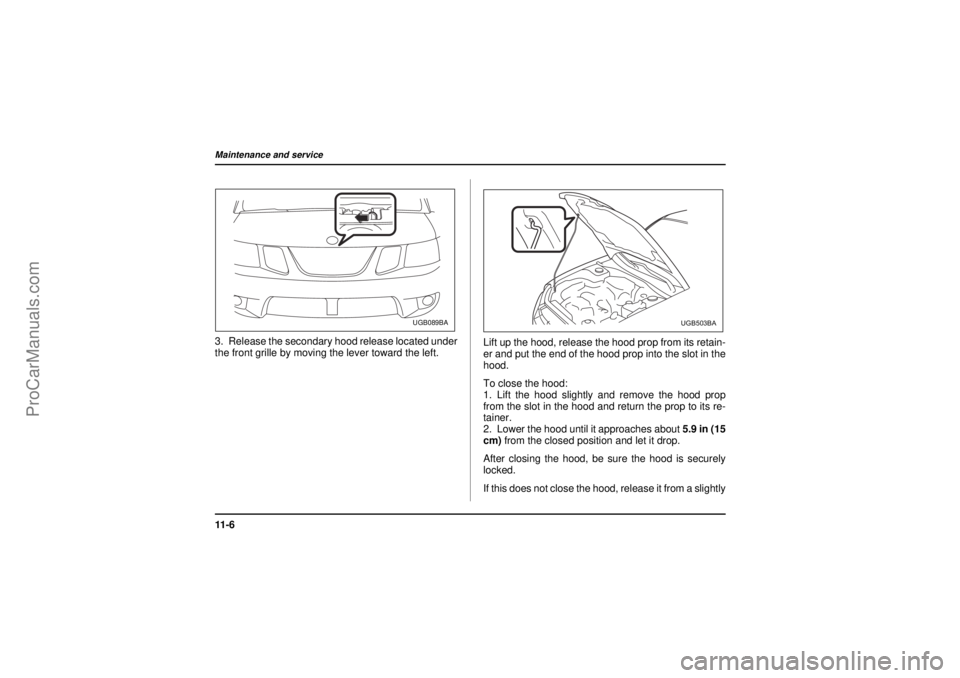
11 - 6Maintenance and service
18 February 2004
3. Release the secondary hood release located under
the front grille by moving the lever toward the left.Lift up the hood, release the hood prop from its retain-
er and put the end of the hood prop into the slot in the
hood.
To close the hood:
1. Lift the hood slightly and remove the hood prop
from the slot in the hood and return the prop to its re-
tainer.
2. Lower the hood until it approaches about 5.9 in (15
cm) from the closed position and let it drop.
After closing the hood, be sure the hood is securely
locked.
If this does not close the hood, release it from a slightly
UGB089BA
UGB503BA
ProCarManuals.com
Page 338 of 444
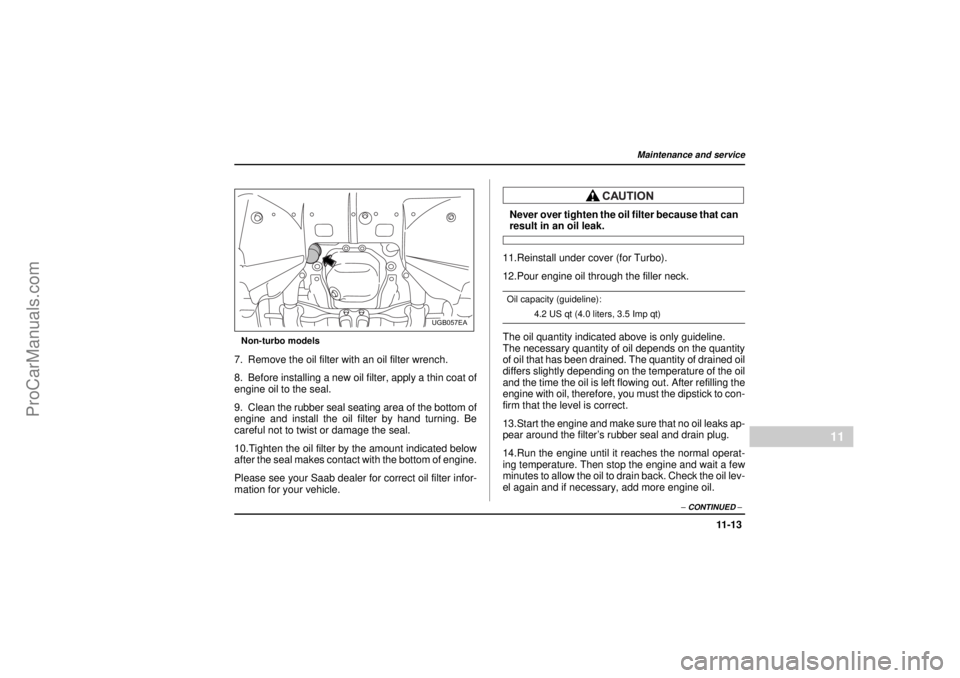
11 -1 3
Maintenance and service
– CONTINUED –
11
18 February 2004
Non-turbo models7. Remove the oil filter with an oil filter wrench.
8. Before installing a new oil filter, apply a thin coat of
engine oil to the seal.
9. Clean the rubber seal seating area of the bottom of
engine and install the oil filter by hand turning. Be
careful not to twist or damage the seal.
10.Tighten the oil filter by the amount indicated below
after the seal makes contact with the bottom of engine.
Please see your Saab dealer for correct oil filter infor-
mation for your vehicle.
Never over tighten the oil filter because that canresult in an oil leak.
11.Reinstall under cover (for Turbo).
12.Pour engine oil through the filler neck.Oil capacity (guideline):
4.2 US qt (4.0 liters, 3.5 Imp qt)
The oil quantity indicated above is only guideline.
The necessary quantity of oil depends on the quantity
of oil that has been drained. The quantity of drained oil
differs slightly depending on the temperature of the oil
and the time the oil is left flowing out. After refilling the
engine with oil, therefore, you must the dipstick to con-
firm that the level is correct.
13.Start the engine and make sure that no oil leaks ap-
pear around the filter’s rubber seal and drain plug.
14.Run the engine until it reaches the normal operat-
ing temperature. Then stop the engine and wait a few
minutes to allow the oil to drain back. Check the oil lev-
el again and if necessary, add more engine oil.
UGB057EA
ProCarManuals.com
Page 364 of 444
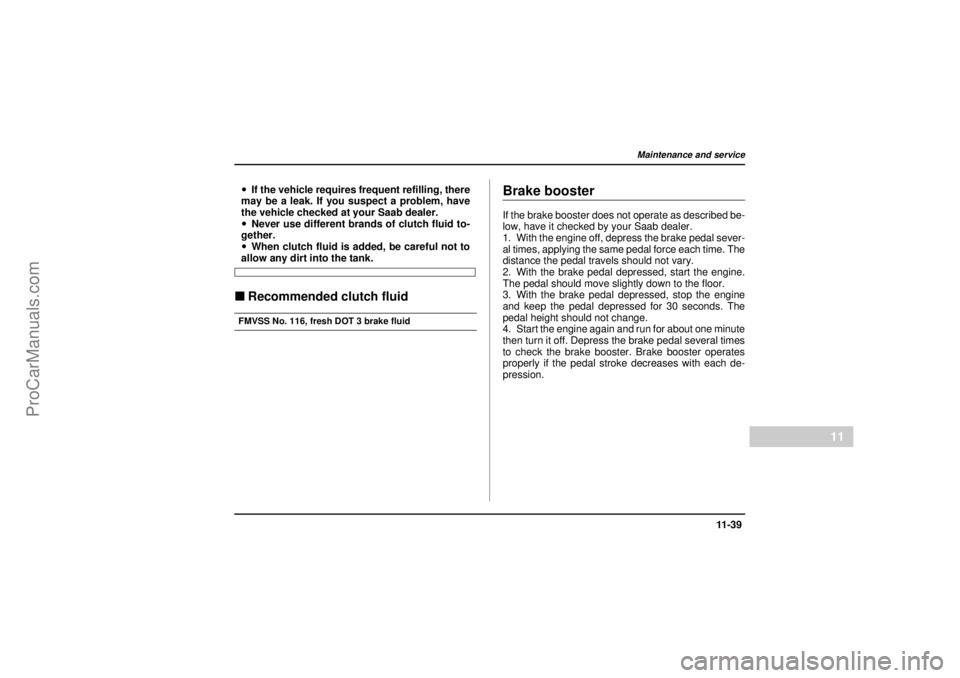
11 -3 9
Maintenance and service
– CONTINUED –
11
26 December 2003
!If the vehicle requires frequent refilling, there
may be a leak. If you suspect a problem, have
the vehicle checked at your Saab dealer.
!Never use different brands of clutch fluid to-
gether.
!When clutch fluid is added, be careful not toallow any dirt into the tank."Recommended clutch fluidFMVSS No. 116, fresh DOT 3 brake fluid
Brake boosterIf the brake booster does not operate as described be-
low, have it checked by your Saab dealer.
1. With the engine off, depress the brake pedal sever-
al times, applying the same pedal force each time. The
distance the pedal travels should not vary.
2. With the brake pedal depressed, start the engine.
The pedal should move slightly down to the floor.
3. With the brake pedal depressed, stop the engine
and keep the pedal depressed for 30 seconds. The
pedal height should not change.
4. Start the engine again and run for about one minute
then turn it off. Depress the brake pedal several times
to check the brake booster. Brake booster operates
properly if the pedal stroke decreases with each de-
pression.
ProCarManuals.com
Page 365 of 444
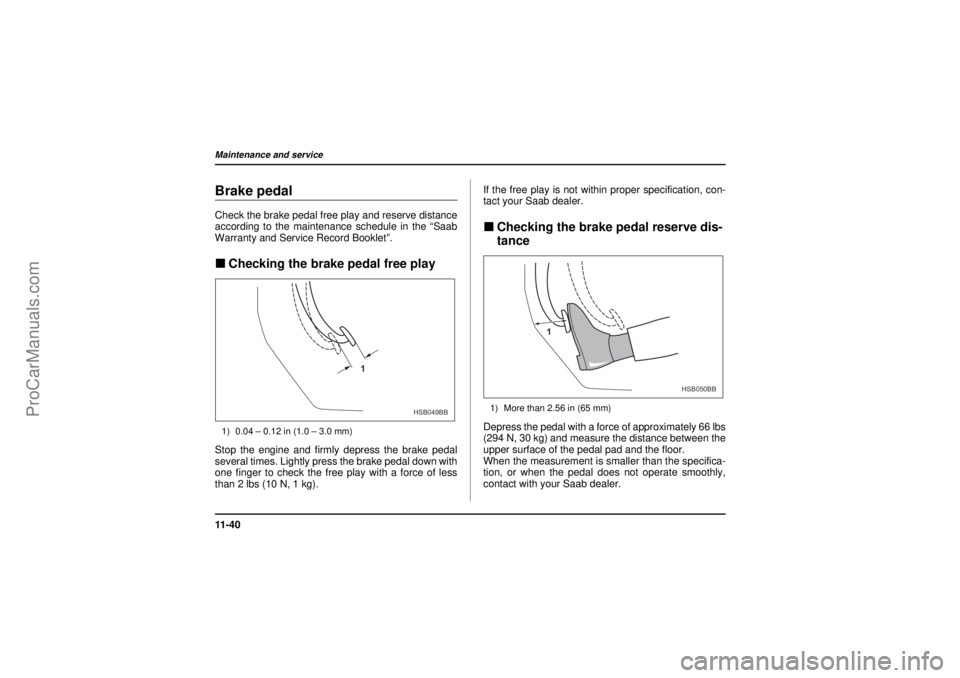
11 - 4 0Maintenance and service
18 February 2004
Brake pedalCheck the brake pedal free play and reserve distance
according to the maintenance schedule in the “Saab
Warranty and Service Record Booklet”."Checking the brake pedal free play1) 0.04 – 0.12 in (1.0 – 3.0 mm)Stop the engine and firmly depress the brake pedal
several times. Lightly press the brake pedal down with
one finger to check the free play with a force of less
than 2 lbs (10 N, 1 kg).If the free play is not within proper specification, con-
tact your Saab dealer.
"Checking the brake pedal reserve dis-
tance1) More than 2.56 in (65 mm)Depress the pedal with a force of approximately 66 lbs
(294 N, 30 kg) and measure the distance between the
upper surface of the pedal pad and the floor.
When the measurement is smaller than the specifica-
tion, or when the pedal does not operate smoothly,
contact with your Saab dealer.
1
HSB049BB
1
HSB050BB
ProCarManuals.com
Page 366 of 444
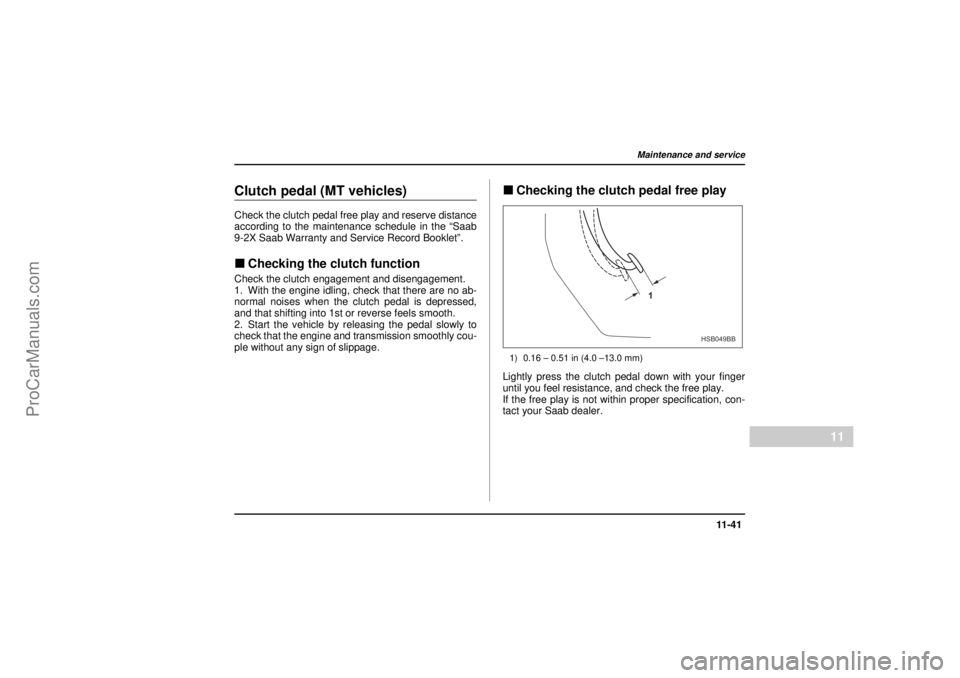
11 -4 1
Maintenance and service
– CONTINUED –
11
18 February 2004
Clutch pedal (MT vehicles)Check the clutch pedal free play and reserve distance
according to the maintenance schedule in the “Saab
9-2X Saab Warranty and Service Record Booklet”."Checking the clutch functionCheck the clutch engagement and disengagement.
1. With the engine idling, check that there are no ab-
normal noises when the clutch pedal is depressed,
and that shifting into 1st or reverse feels smooth.
2. Start the vehicle by releasing the pedal slowly to
check that the engine and transmission smoothly cou-
ple without any sign of slippage.
"Checking the clutch pedal free play1) 0.16 – 0.51 in (4.0 –13.0 mm)Lightly press the clutch pedal down with your finger
until you feel resistance, and check the free play.
If the free play is not within proper specification, con-
tact your Saab dealer.
1
HSB049BB
ProCarManuals.com
Page 367 of 444
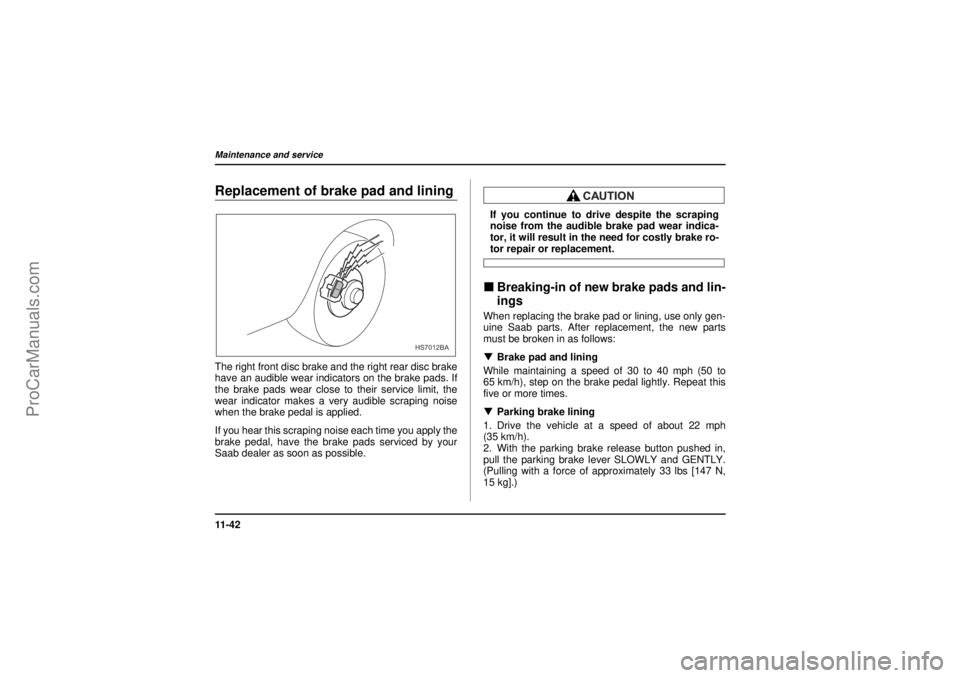
11 - 4 2Maintenance and service
18 February 2004
Replacement of brake pad and liningThe right front disc brake and the right rear disc brake
have an audible wear indicators on the brake pads. If
the brake pads wear close to their service limit, the
wear indicator makes a very audible scraping noise
when the brake pedal is applied.
If you hear this scraping noise each time you apply the
brake pedal, have the brake pads serviced by your
Saab dealer as soon as possible.
If you continue to drive despite the scraping
noise from the audible brake pad wear indica-
tor, it will result in the need for costly brake ro-tor repair or replacement."Breaking-in of new brake pads and lin-
ingsWhen replacing the brake pad or lining, use only gen-
uine Saab parts. After replacement, the new parts
must be broken in as follows:
!Brake pad and lining
While maintaining a speed of 30 to 40 mph (50 to
65 km/h), step on the brake pedal lightly. Repeat this
five or more times.
!Parking brake lining
1. Drive the vehicle at a speed of about 22 mph
(35 km/h).
2. With the parking brake release button pushed in,
pull the parking brake lever SLOWLY and GENTLY.
(Pulling with a force of approximately 33 lbs [147 N,
15 kg].)
HS7012BA
ProCarManuals.com
Page 372 of 444
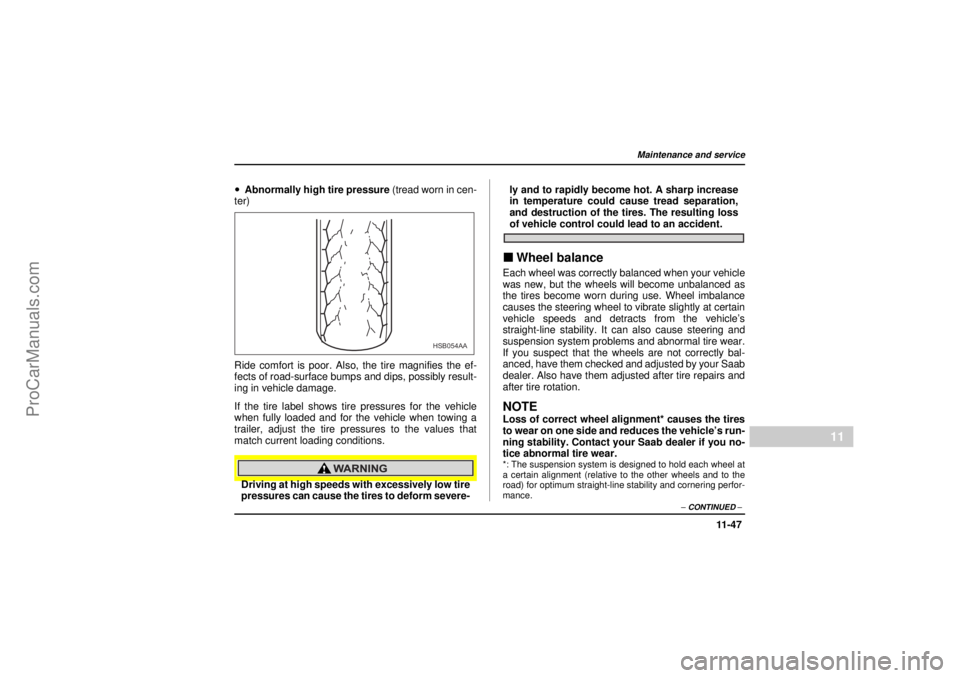
11 -4 7
Maintenance and service
– CONTINUED –
11
26 December 2003
!Abnormally high tire pressure (tread worn in cen-
ter)
Ride comfort is poor. Also, the tire magnifies the ef-
fects of road-surface bumps and dips, possibly result-
ing in vehicle damage.
If the tire label shows tire pressures for the vehicle
when fully loaded and for the vehicle when towing a
trailer, adjust the tire pressures to the values that
match current loading conditions.Driving at high speeds with excessively low tire
pressures can cause the tires to deform severe-ly and to rapidly become hot. A sharp increase
in temperature could cause tread separation,
and destruction of the tires. The resulting loss
of vehicle control could lead to an accident."Wheel balanceEach wheel was correctly balanced when your vehicle
was new, but the wheels will become unbalanced as
the tires become worn during use. Wheel imbalance
causes the steering wheel to vibrate slightly at certain
vehicle speeds and detracts from the vehicle’s
straight-line stability. It can also cause steering and
suspension system problems and abnormal tire wear.
If you suspect that the wheels are not correctly bal-
anced, have them checked and adjusted by your Saab
dealer. Also have them adjusted after tire repairs and
after tire rotation.NOTELoss of correct wheel alignment* causes the tires
to wear on one side and reduces the vehicle’s run-
ning stability. Contact your Saab dealer if you no-
tice abnormal tire wear.*: The suspension system is designed to hold each wheel at
a certain alignment (relative to the other wheels and to the
road) for optimum straight-line stability and cornering perfor-
mance.
HSB054AA
ProCarManuals.com
Page 385 of 444
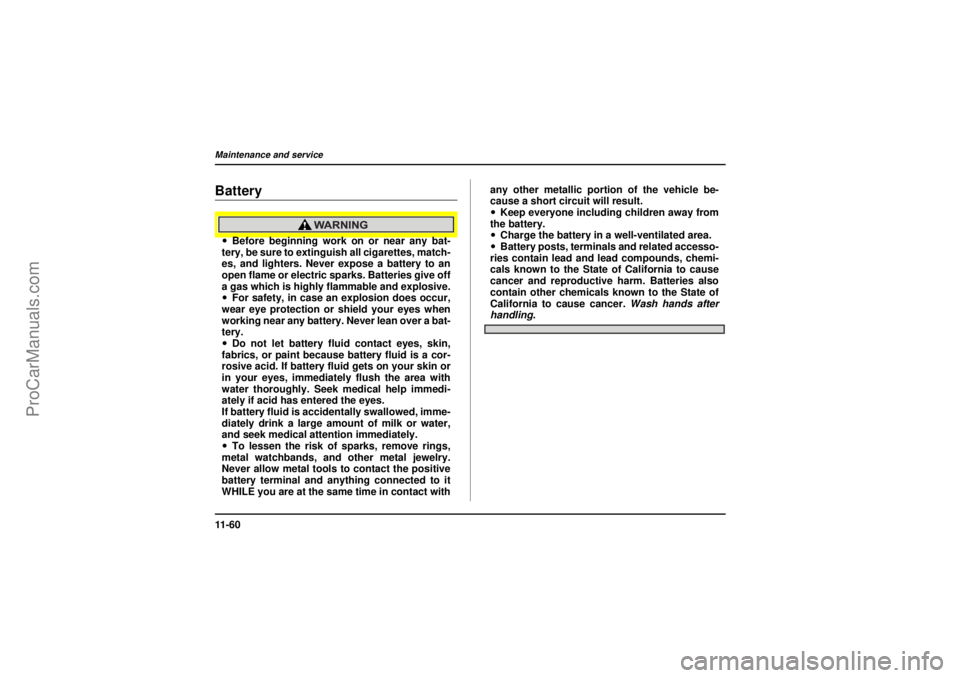
11 - 6 0Maintenance and service
18 February 2004
Battery!Before beginning work on or near any bat-
tery, be sure to extinguish all cigarettes, match-
es, and lighters. Never expose a battery to an
open flame or electric sparks. Batteries give off
a gas which is highly flammable and explosive.
!For safety, in case an explosion does occur,
wear eye protection or shield your eyes when
working near any battery. Never lean over a bat-
tery.
!Do not let battery fluid contact eyes, skin,
fabrics, or paint because battery fluid is a cor-
rosive acid. If battery fluid gets on your skin or
in your eyes, immediately flush the area with
water thoroughly. Seek medical help immedi-
ately if acid has entered the eyes.
If battery fluid is accidentally swallowed, imme-
diately drink a large amount of milk or water,
and seek medical attention immediately.
!To lessen the risk of sparks, remove rings,
metal watchbands, and other metal jewelry.
Never allow metal tools to contact the positive
battery terminal and anything connected to it
WHILE you are at the same time in contact withany other metallic portion of the vehicle be-
cause a short circuit will result.
!Keep everyone including children away from
the battery.
!Charge the battery in a well-ventilated area.
!Battery posts, terminals and related accesso-
ries contain lead and lead compounds, chemi-
cals known to the State of California to cause
cancer and reproductive harm. Batteries also
contain other chemicals known to the State of
California to cause cancer. Wash hands after
handling.
ProCarManuals.com
Page 389 of 444
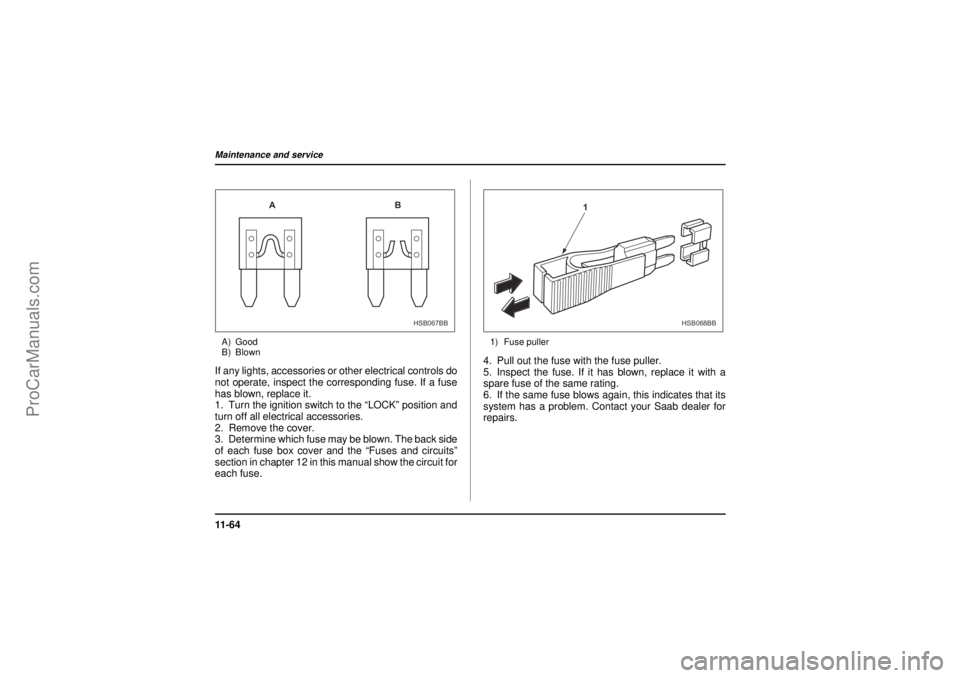
11 - 6 4Maintenance and service
26 December 2003
A) Good
B) BlownIf any lights, accessories or other electrical controls do
not operate, inspect the corresponding fuse. If a fuse
has blown, replace it.
1. Turn the ignition switch to the “LOCK” position and
turn off all electrical accessories.
2. Remove the cover.
3. Determine which fuse may be blown. The back side
of each fuse box cover and the “Fuses and circuits”
section in chapter 12 in this manual show the circuit for
each fuse.
1) Fuse puller4. Pull out the fuse with the fuse puller.
5. Inspect the fuse. If it has blown, replace it with a
spare fuse of the same rating.
6. If the same fuse blows again, this indicates that its
system has a problem. Contact your Saab dealer for
repairs.
AB
HSB067BB
1
HSB068BB
ProCarManuals.com
Page 390 of 444
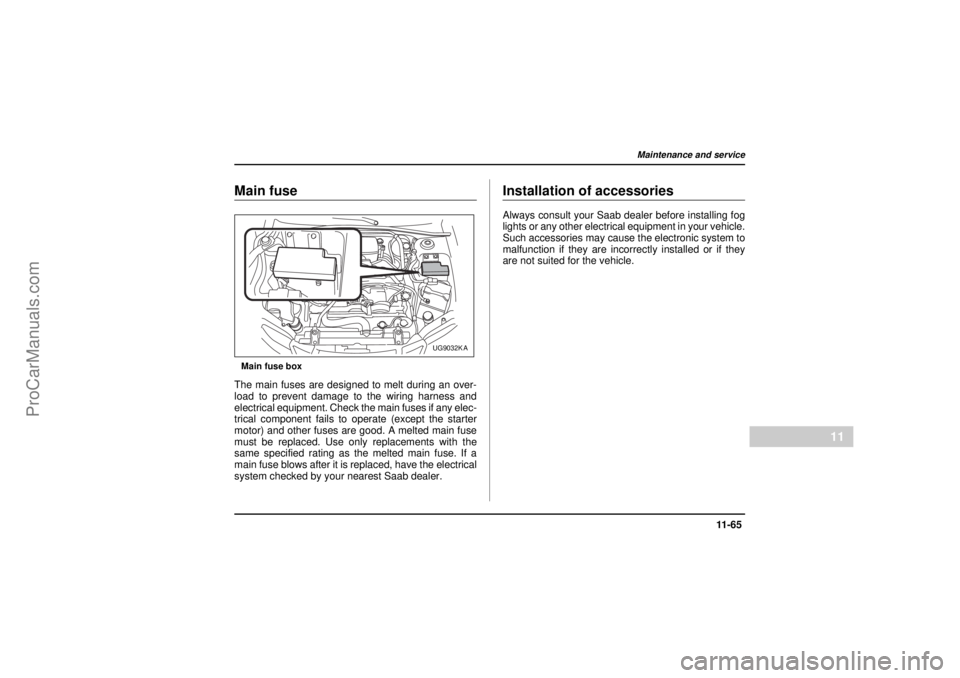
11 -6 5
Maintenance and service
– CONTINUED –
11
26 December 2003
Main fuseMain fuse boxThe main fuses are designed to melt during an over-
load to prevent damage to the wiring harness and
electrical equipment. Check the main fuses if any elec-
trical component fails to operate (except the starter
motor) and other fuses are good. A melted main fuse
must be replaced. Use only replacements with the
same specified rating as the melted main fuse. If a
main fuse blows after it is replaced, have the electrical
system checked by your nearest Saab dealer.
Installation of accessoriesAlways consult your Saab dealer before installing fog
lights or any other electrical equipment in your vehicle.
Such accessories may cause the electronic system to
malfunction if they are incorrectly installed or if they
are not suited for the vehicle.
UG9032KA
ProCarManuals.com